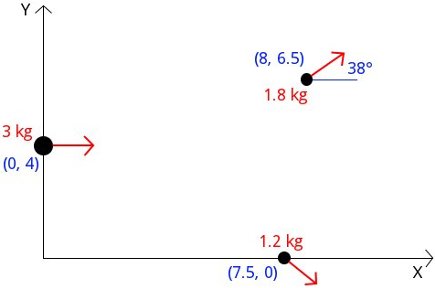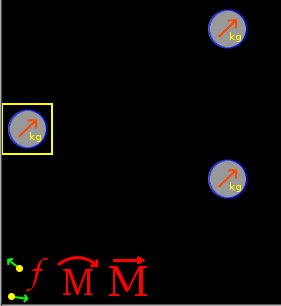Next: Example 13, Previous: Example 11, Up: Examples circular dynamics of particles [Contents][Index]
13.12 Example 12
A mass of 3 kg traveling at 32 m/s, as shown in the figure below, explodes separating into two fragments. If these pass through the coordinates shown and the 1.8 kg fragment has the shown direction, find the speed of both fragments, as well as the direction of the fragment of 1.2 kg.

Solution with FisicaLab
Select the Dynamics group and, inside this, the Circular module. Erase the content of the chalkboard and select the SI system. And add three elements Mobile with linear movement, one element Final system, one element Angular momentum and one element Linear momentum. As show the image below:

To the element Mobile with linear movement to the left, that represents the mass of 3 kg in the initial state, we have, calling it A:
- Name
A
- m
3
- v
32
- x
0
- y
4
- ang
0
- a
0
Now for the element Mobile with linear movement at top, that represents the fragment of 1.8 kg, we have, calling it B:
- Name
B
- m
1.8
- v
vB
- x
8
- y
6.5
- ang
38
- a
0
And to the element Mobile with linear movement at bottom, that represents the fragment of 1.2 kg, we have, calling it C:
- Name
C
- m
1.2
- v
vC
- x
7.5
- y
0
- ang
angC
- a
0
The fragments B and C are the final state, so we add them to the element Final system, which we call final:
- Name
final
- Object 1
B
- Object 2
C
- Object 3
0
- Object 4
0
Now to the element Angular momentum, taking into account that no external moments applied:
- System i
A
- System f
final
- M
0
And to element Linear momentum, no external forces are applied, we have:
- System i
A
- System f
final
- Fx
0
- Fy
0
Now click in the icon Solve to get the answer:
vB = 44.313 m/s ; vC = 49.372 m/s ; angC = 304.018 degrees ; Status = success.